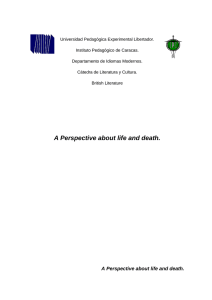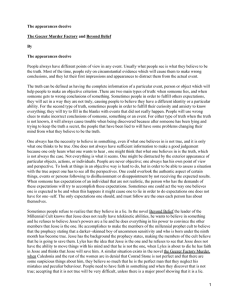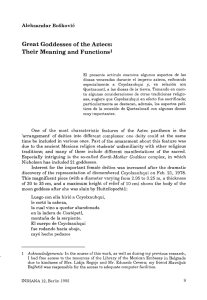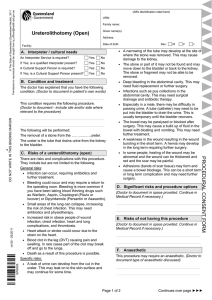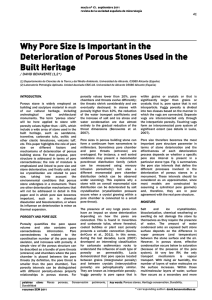NEW BLOOD FROM AN OLD STONE In this paper I am
Anuncio
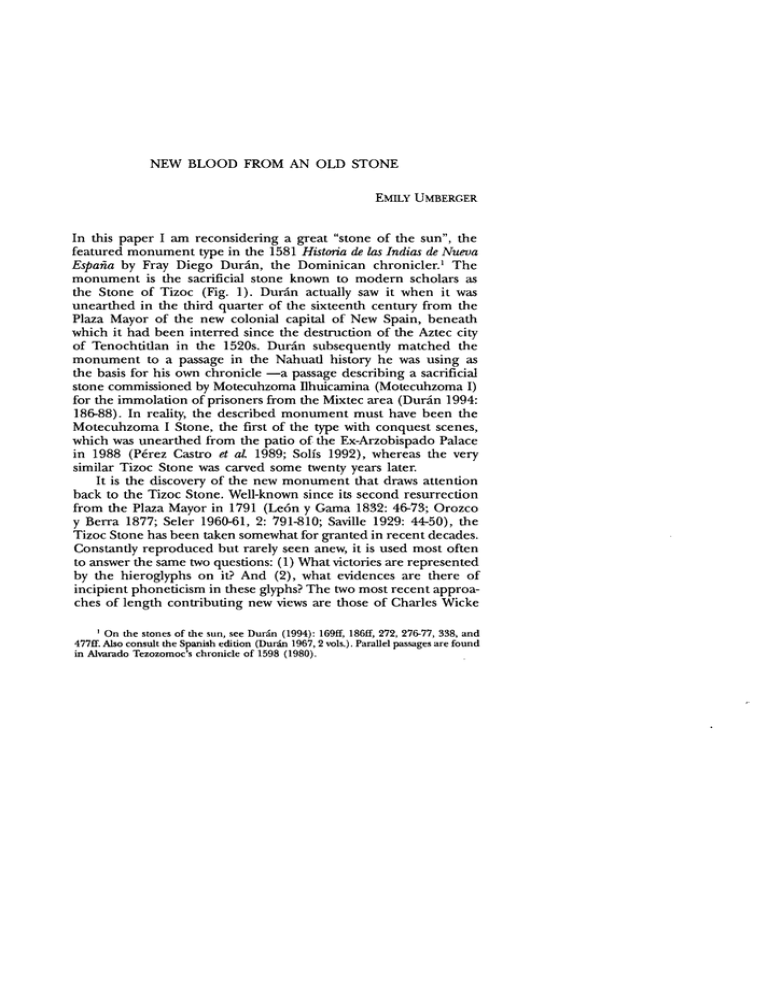
NEW BLOOD FROM AN OLD STONE
EMILY UMBERGER
In this paper I am reconsidering a great "stone of the sun", the
featured monument type in the 1581 Historia de las Indias de Nueva
España by Fray Diego Durán, the Dominican chronic1er. 1 The
monument is the sacrificial stone known to modern scholars as
the Stone of Tizoc (Fig. 1). Durán actually saw it when it was
unearthed in the third quarter of the sixteenth century from the
Plaza Mayor of the new colonial capital of New Spain, beneath
which it had been interred since the destruction of the Aztec city
of Tenochtitlan in the 1520s. Durán subsequently matched the
monument to a passage in the Nahuatl history he was using as
the basis for his own chronicle -a passage describing a sacrificial
stone commissioned by Motecuhzoma Ilhuicamina (Motecuhzoma 1)
for the immolation of prisoners from the Mixtec area (Durán 1994:
186-88). In reality, the described monument must have been the
Motecuhzoma 1 Stone, the first of the type with conquest scenes,
which was unearthed from the patio of the Ex-Arzobispado Palace
in 1988 (Pérez Castro et al. 1989; Solís 1992), whereas the very
similar Tizoc Stone was carved sorne twenty years latero
It is the discovery of the new monument that draws attention
back to the Tizoc Stone. Well-known since its second resurrection
from the Plaza Mayor in 1791 (León y Gama 1832: 46-73; Orozco
y Berra 1877; Seler 1960-61, 2: 791-810; Saville 1929: 44-50), the
Tizoc Stone has been taken somewhat for granted in recent decades.
Constantly reproduced but rarely seen anew, it is used most often
to answer the same two questions: (1) What victories are represented
by the hieroglyphs on it? And (2), what evidences are there of
incipient phoneticism in these glyphs? The two most recent approa­
ches of length contributing new views are those of Charles Wicke
I On the stones of the sun, see Durán (1994): 169ff, 186ff, 272, 276-77, 338, and
477ff. Also consult the Spanish edition (Durán 1967,2 vols.). Parallel passages are found
in Alvarado Tezozomoc's chronicle of 1598 (1980).
242
NEW llLOOD .
EMILY UMBERGER
9
'­
o
(1976) and Richard Townscn
thc conquests and the conqUl
places, and demonstrated th,
the Aztec domain in general
Townsend looked rather al ti
as a cosmogram in which A
cxpanse of sacred space. En]
interprelive possibilities rem 2
basic research and observatio
The Tizoc Stone was carve
was then polished. It may have
at one time wilh a thin coat of
on one pair of figures). It prc
original stone was probably a
is in the form of a cylindrica
diameter by .88 meters in he
is a huge image of the sun; ,­
victor and captive figures ben
important is the paír with lhe
leg" gIyph of the ruler Tizoc
glyph as from the Matlatzinc
Valle}'.
All victor figures wear arel
of lhe type seen on the monu:
the smoking mirror and "sn
Tezcatlipoca was the god wh
he[ore the rise o[ Huitzilop<
SubsequentIy, after Mexica he
become somewhat of a "cade
figures here represent him pn
cial governors of the empirc
figure, in addition to the Toltl
headdress that identifies hi
bird-Ieft". In contrast to the vict,
coslumes. Tbe implication is t
upon capture, that is, wilhou
nochca-Aztec victor figures ar
rity (Umberger n .d.: 136-37;
OriginaBy, the Tizoc Stone
Templo Mayor platform (sce b
lO a less prominent spOl, ",he
to re place it, as was also truc
NEW BLOOD FROM AN OLD STONE
243
(1976) and Richard Townsend (1979: 43-49). Wicke reidentified
the conquests and the conquered figures as deities specific to the
places, and demonstrated that these were intended to represcnt
the Aztec domain in general, not the specific victories of Tizoc.
Townsend looked rather at the monument's form, considering it
as a cosmogram in which Aztec territory corresponded to the
expanse of sacred space. Enlightening as these two studies are,
interpretive possibilities remain unexhausted. Even sorne rather
basic research and observations are still to be done.
The Tizoc Stone was carved from a dark brown andesite, which
was then polished. It may have remained unpainted or it \\'as covered
at one time with a thin coat of red (there are traces of red especially
on one pair of figures). It probably was not polychromed and the
original stone was probably also visible at times. The monument
is in the form of a cylindrical solid and measures 2.60 meters in
diameter by .88 meters in height. Featured on its upper surface
is a huge image of the sun; around the sides are fifteen pairs of
victor and captive figures between earth and sky bands. The most
important is the pair with the victor identified by the "punctured
leg" glyph of the ruler Tizoc and his captive identified by a "net"
glyph as from the Matlatzinco area, that is, the modern Toluca
Valley.
All victor figures wear archaic Toltec costumes (Figs. 2 and 3)
of the type seen on the monumental atlantean figures at Tula, and
the smoking mirror and "smoking leg stump" of Tezcatlipoca.
Tezcatlipoca was the god who dominated the Valley of Mexico
before the rise of Huitzilopochtli, the Aztec-Mexica tribal godo
Subsequently, after Mexica hegemony, Tezcatlipoca seems to have
become somewhat of a "cadet" to Huitzilopochtli. The fourteen
figures here represent him probably as the war captains or provin­
cial governors of the empire (Townsend 1979: 46). The Tizoc
figure, in addition to the Toltec costume, wears the hummingbird
headdress that identifies him as Huitzilopochtli, "humming­
bird-Ieft". In contrast to the victors, the captive figures wear non-Toltec
costumes. The implication is that they have become "Chichimecs"
upon capture, that is, without rights to dominion, while the Te­
nochca-Aztec victor figures are the inheritors of "Toltcc" superio­
rity (Umberger n.d.: 136-37; 1996).
OriginaIly, the Tizoc Stone must have been located on the 1487
Templo Mayor platform (see below); presumably it was moved later
to a less prominent spot, when a new sacrificial stone was created
to replace it, as was also truc in the case 01' the Motecuhzoma 1
244
EMILY UMBERGER
2. Tizoc as Tenochca Huitzilopochtli in archaic Toltec garb and conquering
Matlatzincatl, also caBed Tlamatzincatl (the god Coltzin) on the Tizoc
Stone. Drawing by Emily Umberger
3. Conquest of Tlatelolcatl (Tlatelolca Huitzílopochtli) on the Tizoc Stone.
Drawing by Emily U mberger
NEW BLOOD l<'ROM AN OLD STONE
245
Stone (see Pérez Castro el al. 1989: 14849; Alvarado Tezozómoc
1980: 398). Seemingly the monument was not buried as an offering
or encased within a rebuilt structure in preconquest times. Like
other sacrificial stones, it was probably near the surface when it was
excavated during the building of the Mexico City cathedral, begun
in 1563 (Durán 1994: 187). Felipe SolÍs -kpersonal communication
1997) believes it was found fairIy close to its final preconquest location.
[To begin our reconsideration, the Tizoc Stone would benefit
from a thorough physical exarnination, not only stylistic but also
technical and scientific. Although not the subject of this short
paper, several observations can be made. First is the use of a dense
polished, presumably unpainted, stone. In contrast, the two great
datable state monuments created before it -the Motecuhzoma I
Stone of about 1455-65 and the Great Coyolxauhqui Stone of about
1465-75- are ofunpolished volcanic stones that were subsequently
painted. Why is the Tizoc Stone made of a different material? In
this respect, it is like the monumental greenstone sculptures that
were made at the same time for the 1487 Templo Mayor rebuilding
-the great Coyolxauhqui Head and the Dedication Stone. It might
be asked whether a different team of artists was employed-a tearn
of lapidary artists who used the cylindrical drills and saws whose
distinctive marks are still visible on them. Although important lapi­
dary works were created throughout imperial times, it seems that
only in the 1480s were the most important images of state made
of such dense, polished stones.
Questions also arise as to the different sources of stone used
for Aztec sculptures. In a polity that demanded the materials for
monument manufacture and labor from prospective enemies, the
materials themselves might be significant. Worn and destroyed parts
of the monument should be considered too: not just the canal cut
across the top, which is much discussed, but also the wearing of
the upper surface and the consistently mutilated faces of all fi­
gures. This last is seen also in the Motecuhzoma I Stone, but the
faces are nicked and most are not seriously darnaged. This then
might be a preconquest mutilation, but for what purpose? The
wearing of the upper surface is interesting, in that the polished
layer is totally gone; the stone looks almost "peeled" in places.
Could this be the result of ordinary weathering or did it take a
stronger chemical to dissolve the stone, like sacrificial blood?]
The Tizoc Stone has long been connected to the short reign
of the ill-fated Tizoc, who died only five years after he carne to the
throne, accomplishing nothing much beyond the beginning of a
246
EMILY UMBERGER
new phase of the Templo Mayor. It is still to be matched more
exactly to the historical events of its time. This is not diffieult to
do using the evidence of Durán's Historia, the Codex Telleriano­
Remensis, and short passages in other sourees. The hieroglyph of
Tizoe dates the monument between 1481 and 1486; while the "Lista
de los reyes de Tenochtitlan" puts a temalacatl ("round stone")
more exaetly in the third year of Tizoe's reign, presumably 1484
(Anales de TlateÚJlco 1980: 17). Interestingly, the Codex Telleriano­
Remensis (Keber 1995: f. 38v) also dates the sacrifice of victims from
Tzinacantepec in the Matlatzinco area, the featured conquest on
the Tizoc Stone, to this year (Fig. 4).
This folio and the one following (39r) give us the probable
order in which monuments were created in the 1480s. The narrative
begins with Tizoc's aecession to the throne in 2 House 1481, upon
the death ofAxayaeatl. Two years later in 4 Reed 1483, Tizoc orde­
red the foundation laid for a new phase of the Templo Mayor, and
aecording to the illustration, a eaptive was saerificed on the oceasion.
Tizoc was following the pattern set by his three predecessors, who
all rebuilt the Templo Mayor, that is, the mythic site of Coatepec,
Serpent Mountain, where Huitzilopochtli was born like the rising
sun and defeated his enemy sister Coyolxauhqui and innumerable
brothers. Tizoe's last two predeeessors, in addition, had had new
sun stones and Coyolxauhqui images carved. Consulting both history
and divinatory books, Tizoc no doubt looked for an appropriate
date to commemorate with his construction. He must have chosen
4 Reed 1483 because it was the anniversary of the foundation 52
years earlier in 1431 of the Triple Allianee empire which Tenoch­
titlan now dominated. From Tizoc's perspective, no similarly
important date was to occur for many years. 2
In the following year, 5 FIint 1484 (Fig. 4), upon the completion
of the pyramid base, the saerifice of the Tzinacantepec captives
must have taken place on the Tizoc Stone. Next to the victim are
the words piedra sangrada ("bloodied stone"). Given that the blood
is pouring down the stairways of the pictured pyramid, the stone
2 The next date celebrated by the creation of a series of monuments seems to have
been 12 Reed 1491. These monuments ínelude a colossal head. the great "Coatlicue"
and other rnernbers of the sarne set, a set of four cihuateteo, an archaízíng cihuateot4 and
possíbly abone with an engraving of Ahuitzotl on it. The date 12 Reed inscribed on
sorne of these, íf cornmernorative of an historical event, would correspond to 1491,
given the late style of the sculptures. The event celebrated might have been an anniversary
of a rnythological event, the descent of the tzitzimime before the birth of the fifth sun,
as suggested by Elizabeth Boone in her recent reconsideratíon of the "Coatlicue" as one
of these tzitzimime (Boone n.d.).
4. Codex Telleriano-Remensis, foliqs 38v-39r, depicting sequence of events
in building of Templo Mayor between 148487 (Keber 1995).
Courtesy of the Bibliotheque Nationale, París
~~
2
~~
5
6
~
o
o
3
7
~
av
8
r#fS?~
!
13
~
nn
14
~
11
mE 15
5. Tribal name glyphs (?) on Tizoc Stone
(redrawn after Dibble 1971: fig. 2)
12
248
EMILY UMBERGER
was presumably on the temple platform. A female victim is also
depicted, indicating her dispatch in the same year. Her nude and
displayed position is reminiscent of images of the defeated Coyol­
xauhqui, and thus may date the Coyolxauhqui sculpted for this
temple phase to 1484 also. This might have been the greenstone
Coyolxauhqui Head mentioned aboye, which would have been
placed on the platform too rather than below (Pasztory 1983: 153).
In 7 Rabbit 1486 Tizoc died and was succeeded by his brother
Ahuitzotl, who finished the temple the following year, 8 Reed
1487. Ahuitzotl's initiation of the temple is illustrated in Telleriano­
Remensis with the depiction of sacrificial victims and the sign of a
new fire lighting. The sacrificial victims derived from Ahuitzotl's
own battles against <;zicoac, Cuetlaxtlan, and Tezapotitlan in Vera­
cruz or Teozapotlan (Zaachila) in Oaxaca (Keber 1995: 80-81, 273,
335; Anales de Tlatelolco 1980: 60). The lighting of a new fire was
another action appropriate for the completion of a new building
(these did not occur just al cycle beginnings).
The Tizoc Stone must have remained on the platform for use
again during the great sacrificial ceremony of 1487 -assuming
that Ahuitzotl had not yet had another sacrificial stone carved. 3
Durán (1994: ch. XLIV) tells us that at the 1487 ceremony, the four
sacrificers-the Tenochca, Texcocan, and Tlacopan tlatoanis and
the Tenochca cihuacoatl Tlacaelel-were located at different sites
on the platform of the temple. Ahuitzotl was in front of the image
of Huitzilopochtli and Tlacaelel was at the Sun Stone-that is
presumably, the Tizoc Stone. Carved only three years earlier, it
must originally have been intended for this purpose, and its imagery
of generalized conquest is appropriate for such a celebration of
the empire. In short, the stone commemorates an important victory
of Tizoc's (in the Matlatzinca area), but among previous victories
that encompassed the important provinces of the empire, as Wicke
has pointed out. During the ceremony, the victims from all parts
of the empire were lined up along the four causeways to be sacrifi­
ced at the temple at the "crossroads" of the cosmos, the meeting
place of the aboye and below as well as the four directions. On the
Tizoc Stone the container for blood is in the center of the sun,
while the groundline representing the empire's expanse has around
its perimeter four flintknife-lined mouths, entryways to the under­
world at the four quarters (Townsend 1979: 46). Thus the stone's
3 No temalacatl is mentioned as having been installed again until twe1ve years later
in 6 Rabbit 1498 (Chímalpahín 1965: 225).
NEW BLOOD FROM AN OLD STONE
249
iconography anticipates the ceremony in which Tizoc intended to
participate when he had the monument carved. As suggested in
the past, the channe1 to allow for the flow of blood from the
central bowl may have been hollowed out during the sacrifices
because of the great amount of blood. 4
Ahuitzotl, in tu m , used the occasion for a type of second
coronation ceremony (KIein 1987: 323-24), his first not having
been satisfactory, although his specific conquests and their victims
are not recorded on Lhe sun stone used. He also chose to emphasize
the actual year of the ce1ebration, 8 Reed, which previously had no
strong historical or mythical connotations, in preference to Tizoc's
chosen date of 4 Reed, which afterall was not in Ahuitzotl's reign.
As such, 8 Reed is the featured date on the so-caBed Dedication
Stone of the new temple.
Finally, in this reconsideration of the Tizoc Stone, I would like
to throw into question sorne ofthe basic premises about the captive
figures and their hieroglyphs (as first suggested in Umberger n.d.:
136-38). Seemingly simple in composition, perhaps the strong
resemblance of tlle Tizoc Stone's motifs to Mixtec art (Pasztory
1983: 147-48) has deceived us into not considering the possibilities
of different, more complex readings from a Mexica perspective.!í
1 refer specifically to the identification of the hieroglyphs as place
glyphs (Fig. 5). The fact that Lhey do not have locative endings
suggests another possibility-that they might be tribal name glyphs
of a type that are also [ound in Aztec manuscripts like the Codex
Boturini (e.g. 1944: 2) and Codex Mendoza (Fig. 6).
In addition, considering these codex illustrations, it could be
suggested that the glyphs do not function alone, that together with
the figures they refer to a generalized concept known from other
Aztec accounts. This is the concept of the citizcn of a town or area
used to designate, simultaneously, the polity's ruler, deity, and
generic warrior citizen. In other words, we do not need to choose
between these possibilities «(f Wicke 1976: 217). The term referen­
< Two allernatives have been suggesled-lhal it was made lO lower lhe leve! of
blood in the container, 01' thal it was a later dfort t.o cut up the stone in colonial times.
Duran mentions that t:lw Mexicans wanted to make it into a baptismal basin (1995: 187).
Eduardo Donglas (personal commullicatioll 1997), however, has pointed out to me
another Azt.ec blood sacrifice vesse! with a similar cut (in the Sala Mt'xica of the Museo
Nacional de Antropología).
" The Mixtec aspects an: in the fOl'ms of the eal'th and sky band, the solar disc,
and the use of hieroglyphs naming figures, although in the Mixteca these would be
calendrical names. Within litis Mixtec framework the Mexica anists clothed the warriors
in costume part~ tha!: might al50 be seen in the Mixteca, but the consistent contrast
between Tolt.ec ami non-Toltec garb is purely Mexica.
250
EMILY UMBERGER
6. Drawing of tribal name glyphs in Codex Mendoza folios 2v and 42r
(Berdan ami Anawalt 1992, 4: 10 and 89). Courtesy of lhe University
of California Press
7. Paynal and Tezcatlipoca as depicled in the "Primeros Memoriales"
(Sahagún 1993: f. 261). Courtesy of the Ulliversity of Oklahoma Press
NEW BLOOD "ROM AN OLD STONE
251
ced, which is used especially in contexts of warfare, is formed by
the place name (usually without locative ending) plus the suffix
-catl ("person") (Andrews 1975: 332-33). Examples of the varied
usages of this term for rulers and deities as well as generic warriors
are found in the Anales de Tlatelolco (1980: 57), the Codex ChimalPopoca
(1992: 113-14), the Codex Magliabechiano (fs. 5Ov-57r, in Boone 1983:
203-04), and a modern dialogue collected in Tepoztlan (Karttunen
and Wara Céspedes 1982)."
Thus, I suggest the following identities for the captive figures
on the Tizoc Stone, beginning with Tizoc's captive and proceeding
to the right (Fig. 5): (1) Matlatzincatl (Matlatzinco area of which
Tollocan was the capital) (Fig. 2), (2) Tochcatl (Tochpan province
in northern Veracruz), (3) Ahuilizapanecatl (Ahuilizapan provin­
ce in central Veracruz), (4) unknown (tree with water streams),7
(5) Culhuacatl (Culhuacan), (6) Tenayucatl (Tenayucan),H (7) Xochi­
milcatl (Xochimilco, which had possessions in Morelos), (8) Chalcatl
(Chalco province), (9) Azcapotzalcatl (Azcapotzalco) (?),!J (10) Acol­
huacatl (Acolhua province), (11) Tepanecatl (Tepanec province),!fl
(12) Tlatelolcatl (Tlatelolco) (Fig. 3), (13) unknown (sun on moun­
tain), (14) Mixtecatl (Mixtec province of which Coaixtlahuacan
was the capital),ll and (15) Cuetlaxtecatl (Cuextlaxtlan province
in central Veracruz) .I~ If these are generally correct, those that are
identified form two blocks on the monument, Valley of Mexico
polities in glyphs 5 through 12 (including extensive traditional
h Sueh pl'Ovinee-specifie 01' tribal lerms may have served also as tides of Aztee
govemoes. The Codex Mendoza, for instanee, refees 10 me Pedaealead ofPetlaealco (Berdan
and Anawalt 1992: f20r) and Durán (1994: 180-81) refers 10 the Azlee governor of Ihe
Pinome as Pinotl.
7 Could it be Cuauhnahuaead as in Fig. 6? The trce form is of ¡he light typc, bm
me eodex version has l'Oots bdow, not water, and a speeeh sel'Oll to refer to naÍlua(tl),
"good speeeh" (Berdan and A.Ilawalt 1992, 1: 201). One would not expect the speeeh
seroll on the selllpted version, but the presence of water is puzzling.
" As suggested by Nicholsol1 (1973: 5).
'. This is a new suggestiOI1. Azeapotzalco means "on the ant hill". The glyph represents
a hiU wim a "lid" tipped 10 the sirle (an ant hiIl?). The animal does not look partieularly
ant-like. ha\'ing fonr legs rather lhan six, but in this it resembles the ant in the
Azcapotzalco glyph in the Codex Xolotl (1980, 2: plancha 6 E3). It does not have a
spider's spinneret, as suggested by Wicke (1976: 215).
10 Dibble (1971: 327) sees ¡he glyph as represelltillga "l'Ock bridge", thus the place
name Tepanoayan, but the newly found sacrificial stone of Motecuhzoma 1 represents
the same figure next 10 a grouping ofstones (tetl) and stone knives (tecpatC¡, not aligned
in a bridge-like formo The tetl glyph is used for dIe tribal name Tepanec in rhe Codex
Bot1lrini (1944: 2), and dIe ddty costume is easily recognized as that of the Tepanec god
Otontecuhtli (fOl' whích see Brown 1988; Wicke 1976).
11 A~ suggested by Wicke (1976).
12 Compare these idcntifications wim the place names in Dibble (1971: 326-28),
Nicholson (1973: 4-5), and Wicke (1976).
252
EMILY UMBERGER
holdings outside the ValIey) and foreign provinces in the Toluca
area, Oaxaca, and Veracruz (14 through 3). Most are the tribal
designations of extensive provinces, but a few are important towns:
Culhuacan and Tenayucan, ancestral Toltec and Chichimec towns
that are the first two, foundation conquests in the Codex Mendo'1.a
(frontispiece), and Azcapotzalco, the Tepanec capital defeated by
the Triple Alliance cities in 1428.
In addition to the glyphs, also problematic al are the deity
identifications and, at the same time, how this core issue in
Mesoamerican iconography is generally treated. Wicke used time­
honored procedures when he identified these figures by what are
considered "diagnostic" traits depicted in deity representations in
the Primeros Memoriales (Sahagún 1993) and Durán (1977). Thus,
he (Wicke 1976: 220) calls deities 1 and 12 on the Tizoc Stone
(Figs. 2 and 3) Tezcatlipoca and Paynal, respectively, because of tlle
facial stripes and slcLff (resembling a tlachieloni or "instrument with
which to see") of one and the "starry sky" mask of the other (com­
pare them to Fig. 7). However, what happens if we reverse the
procedure, and identify the deities from their tribal glyphs? We
know from Durán's (1994: 261, 269) accounts of these particular
conquests that the conquered Tlatelolco god was another version
of Huitzilopochtli, since the Tlate10Jca shared the Tenochca's Mexica
heritage, and the Matlatzinca god was calIed Coltzin, as well as
Tlamatzincatl, an inversion of Matlatzincatl (for references, see
Umberger 1996: 92).
If the glyphs and figures are interpreted as suggested aboye,
the results are interesting. If secn as tribal names, sorne glyphs
represent more politically important place s and broader areas than
the sometimes obscure towns that scholars have tried to match them
with. For instance, figure 10, if identified as the Acolhuacatl,
represcnts the entire Acolhua area, rather than the towns of
Acolhuacan or Acolman. Likewise, if the Hne of stones represented
next to figure 11 identify him as the Tepanecatl, he represents the
Tepancc area encompassing equally vast areas inside and outside
the Valley, rather than Tepanoayan or TecaxÍc. Sorne of the aboye
identifications are more hypothetical than others and two figures
remain unidentified, but the general principIe is sound.
Other problematic implications of these suggestions need to
be either resolved or accepted as unresolvable at present. In the
cases of most conquests outside the Valley we cannot name the tribal
deity specificalIy, unless we know from a written source his or her
local name (as in the case of Coltzin). In addition, ir captive 12,
NEW BLOOD J:iROM AN OLD STONE
253
the Tlatelolcatl (Fig. 3), is Huitzilopochtli, where is the "diagnostic"
hummingbird headdress, worn by Tenochca Huitzilopochtli (in
Fig. 2)? I suggest that Tlatelolca Huitzilopochtli lost it along with
his rank upon conquest, although retaining the "starry sky" mask
they both wear. This is not to say that it is impossible to identify
deity figures by costurne parts in Aztec art, but rather that in contexts
of conquest, cerl.c-un politically import.'lnt gods, like Huitzilopochtli
and Tezcatlipoca, can have quite varying images, lacking perhaps
what we consider necessary accoutrements. It is already well-known
that their actual sculptures were dressed and decorated differently
depending on the ritual occasion. It needs to be acknowledged
also that victorious gods took on the powerful traits of the defeated
(Sahagún 1950-82, Book 3, 2nd ed., revised: 5), while the defeated
lost these and gained humiliating paraphemalia. On tl1e Tizoc
Stone these include Chichimec rather than Toltec garb and the
decorations of death and sacrifice, the aztaxelli arrangement of
double feathers on all the captives' heads. The latter are also seen
in both Codex Mendoza and Telleriano-Remensis depictions of sacrificial
captives (Figs. 4 and 6).
The Tizoc Stone does not represent the captured gods as they
were depicted in their home towns, but rather casts them into
their new positions in Tenochca thought. In the end, Wicke may
be correct in that Tlatelolca Huitzilopochtli and Matlatzinca Coltzin
might have been recast as the "cadet" gods Paynal and Tezcatlipoca
upon their exile in Tenochtitlan. Coltzin as Tlamatzincatl in Tenoch­
titlan was, in fact, identified as a type of Tezcatlipoca (Sahagún
1950-82, Book 2: 118). Vet, we come closer to Mexica thought, I
believe, by reconstructing the complexities of the changing identities
of these tribal personae, rather than merely trying to give them
names. In other words, no god in late postclassic Mexico had a
single, monolithic identity.J~
REFERENCES CITED
ALvARADO TEZOZOMOC,
Hernando
1980 Crónica mexicana, 3rd ed. Biblioteca Porrlm, Mexico.
1980 l1nales de Tlatelolco y Códice de Tlatelolco. Prepared and annotated
hy Heimlch Berlín, with summary and interpretation by Robert
H. Barlow, 2nd ed. R. Porrúa, Mexico.
¡,
Thcse ideas are arglled al grealer lenglh in a book in prepar,llion.
EMILY UMBERGER
254
ANDREWS, J. Richard
1975 Intmduetion to Classieal Nahuatl. University of Texas Press, Austin.
BERDAN, FRANCES F., and Patricia R. Anawalt
1992
The Codex Mendoza, 4 vols. University of California Press,
Berkeley.
BOONE, Elizabeth Hill
n.d. The "Coatlicues" at lhe Templo Mayor, rnanllscript prepared
in 1997.
1983 Tite Codex Ma{{liabeehiano and the Lost PrototyjJe o{ the Ma{{lia­
beehiano Group. With a reprint of the Zelia Nuttall facsimile of
1903. Ulliversily of California Press, Berkeley.
BROWN, Belty Ann
1988 All Around the Xocotl Pole: Reexamination of an Aztec
Sacrificial Ceremony. In Smoke and Mist: Mesoamerimn Studies in
Mernmy o{ Thelma D. Sullivan, edited by J. Kathryn Josserand
and Karen Dakin: 173-89. British Archaeological Reports.
Oxford.
CHlMALPAHIN CUAUlITLEHUANITZIN, Francisco de San Antón Muiion
1965 Relaciones ori¡!j,nales de Chaleo A1IUlquemecan, edited aml translated
by Silvia Rendón. Fondo de Cultura Económica, Mexico.
Codex Boturini
1944
Tira de la peregrinación. Echániz, Mexico.
Codex ChimalPopoca
1992 Histmy and Mytholof!,Y o{ the Aztees: The Codex ChimaljJOpoca,
translated from Nahuatl byJohn Bierhorst. University of Arizona
Press, Tucson.
DlBBLE, Charles
1971 Writing in Central Mexico. In Handbook o{ Middle American
Indians, edited by Robert Wauchope, Gordon F. Ekholm,
and Ignacio Bema!, 10: 322-332. University of Texas Press,
Allstin.
DURÁN, Fray Diego
1967 Historia d,e las Indias de Nueva Espaiw e hlas de la Tierra Fi'r1llR,
2 vols., prepared by Ángel María Geuibay K. EditOlial Pornía,
México.
NEW BLOOD FROM
AN
OLD STONE
255
1971 Book ol the Gods and Rites and the Ancient Calendar, translated
and edited by Fernando Horcasitas and Doris Heyden. Uni­
versity of Oklahoma Press, Norman.
1994 History ol the Indies ol New Spain, translated and edited by Doris
Heyden. University of Oklahoma Press, Norman.
KARTTUNEN, Fmnces, and GILKA Wara Céspedes
1982 The Dialogue of El Tepozteco and His Rivals, September, 1977.
Tlalocan 9: 115-41.
KEBER, Eloise Quiñones
1995 Codex Telleriano-Remensis: Ritual, Divination, and History in a
Pictarial Aztec Manuscript. With facsimile. University of Texas
Press, Austin.
KLEIN, Cecelia F.
1987 The Ideology of Autosacrifice at the Templo Mayor. In The
Aztec TemPlo Mayor, edited by Elizabeth Hill Boone: 293-370.
Dumbarton Oaks, Washington.
LEÓN
y
GAMA, Antonio de
1832 Descripción histórica y cronológica de las dos piedras... , 2nd ed. Ciu­
dadano Alejandro Valdés, México.
NICHOLSON, H. B.
1973 Phoneticism in the Late Pre-Hispanic Central Mexican Writing
System. In MesoarneTÍcan Writing Systems, edited by Elizabeth P.
Benson. Dumbarton Oaks, Washington.
1985 The New TenochtitJan Templo Mayor Coyolxauhqui-Chantico
Monument. Indiana, 10, Gedenkschrift Gerdt Kutscher, Teil 2: 77­
98.
OROZCO
y
BERRA, Manuel
1877 El cuauhxicalli de Tizoc. Anales del Museo Nacional de México 1:
3-39.
PASZTORY, Esther
1983 Aztec Art. Abmms, New York.
PÉREZ CASTRO LIRA, Guillermo, Pedro Francisco Sánchez Nava,
María Estéfan, Judith Padilla y Yedra, and Antonio Gudiño
Garfias.
1989 El cuauhxicalli de Moctezuma I. Arqueología 5: 131-51.
EMILY UMBERGER
256
SAHAGÚN, Fray Bemardino de
Primeros memoriales. Facsimile edition. University of Ok.lahoma
Press, Nonnan, in cooperation with the Patrimonio Nacional
and the Real Academia de la Historia, Madrid.
1950-82 Florentine Codex: General History oI the Things oI New Spain,
translated by Arthur J. O. Anderson and Charles E. Dibble, 11
vols. The School of American Research and the U niversity of
Utah, Santa Fe.
SAVlLLE, Marshall H.
1929 Tizoc, Great Lord of the Aztecs. Contributions, Museum oI the
American Indian, Heye Foundation 7 (4).
SELER, Eduard
1960-61 (1902-23) Gesammelte Abhandlungen zur Amerikanischen Sprach­
und Alterthumskunde. 5 vols. Akademische Druck- und Verlag­
sanstalt, Graz.
Soús, Felipe
1992 El temalacatl-cuauhxicalli de Moctezuma Ilhuicamina. In Azte­
ca Mexica, Las culturas del México antíguo: 225-32. Lunwerg,
Madrid.
TOWNSEND, Richard F.
1979 State and Cosmos in the Art f?f Tenochtitlan. Dumbarton Oaks,
_~ashington.
UMBERGER, Emily
n.d. Aztec Sculptu'ms, Hieroglyphs, and Histury. Ph.D. dissertation, Co­
lumbia University, 1981.
1987 Events Commemorated by Date Plaques at the Templo Mayor:
Further Thoughts on the Solar Metaphor. In The Aztec TemPlo
Mayor, edited by Elizabeth H. Boone: 411-49. Dumbarton Oaks,
Washington.
1996 Art and Imperial Strategy in Tenochtitlan. In Aztec Imperial
Strategies, by Frances F. Berdan, Richard E. Blanton, Elizabeth
H. Boone, Mary G. Hodge, Michael E. Smith, and Emily
Umberger: 85-106. Dumbarton Oaks, Washington.
WICKE, Charles
1976 Once More Around the Tizoc Stone: A Reconsideration. Actas
del 41 Congreso Internacional de Americanistas, 2: 209-22.

